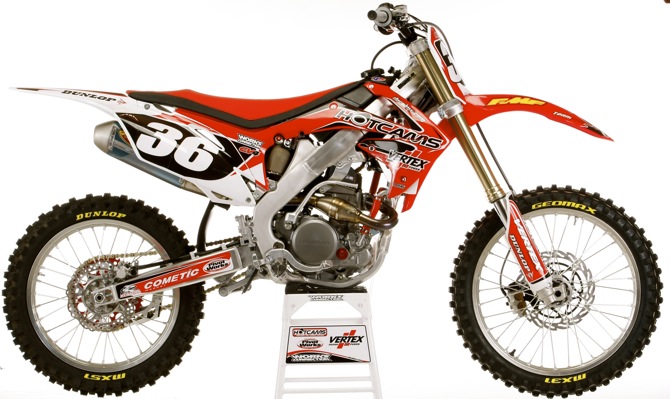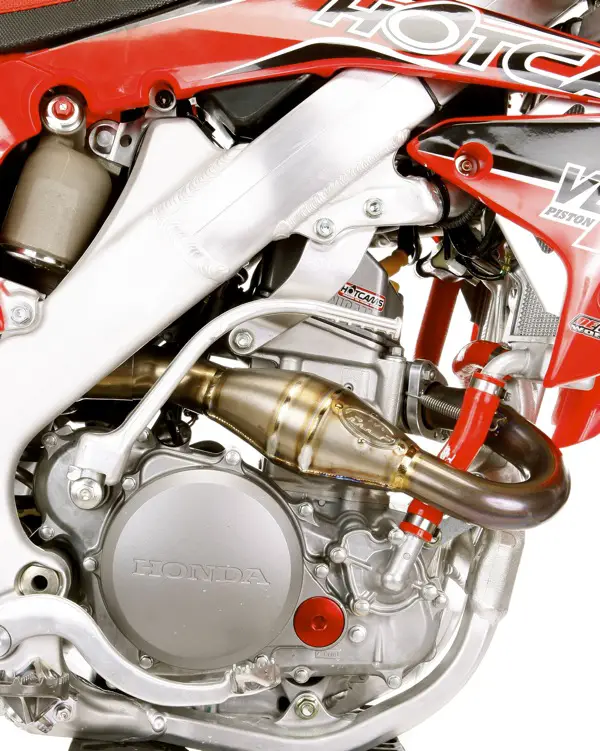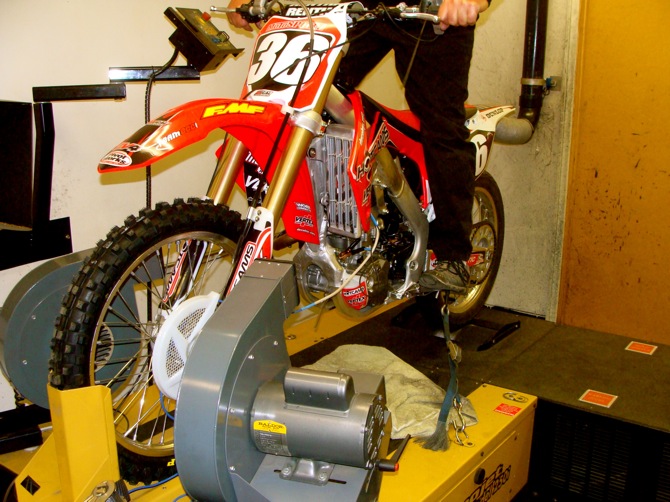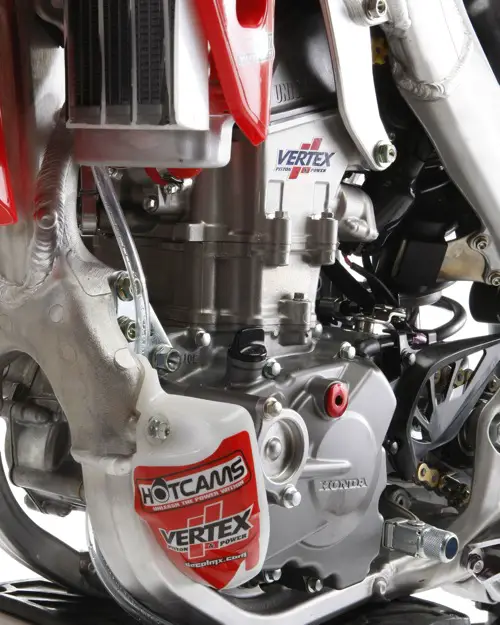VIDEO: WHERE TO SPEND YOUR HOP-UP MONEY… PIPE? CAM? OR PISTON? WE DYNO EACH ONE

The big three of the hop-up world are pipes, cams and pistons, this trinity of parts compromises a major portion of every serious race program. The question is, what does does each piece of the hop-up puzzle bring to the overall picture? The motocross world is full of anecdotal stories of 65 horsepower CRF450s with nothing more done to them than one tooth skipped on the camshaft sprocket and a muffler modified with a butter knife. But, the ravings of backyard mechanics aside, the MXA wrecking crew wanted to find out how much power was in the big three singularly and in combination.
IT WASN’T AN EASY TASK, BUT WE FELT UP TO IT?ONCE WE GOT OUR DUCKS IN A ROW. THERE WERE FIVE DUCKS.

It wasn’t an easy task, but we felt up to it, once we got our ducks in a row. There were five ducks.
(1) Bike: We elected to uses a 2012 Honda CRF250 as our test bike. We needed a brand-new never been run CRF250 because, we needed a fresh piston for our starting point, so that when we installed a new piston later in the procedure that it wouldn’t run better because it was new (or vice versa). Plus, we have a lot of Honda CRF250 experience and had been making multiple runs on our well-used test bike to test pipes and other products. This would give us a good basis for comparison when we did the race portion of this test.
(2) Dyno: Since we needed to make multiple dyno runs and test every possible combination of cam, exhaust and piston, we needed to commandeer a dyno for what turned out to be 18 different engine combinations?plus the time it would take us to put the cam in, take it out, put the piston in, take it out and swap pipes, ignitions and other test possibilities. All the dyno testing had to be done under the same atmospheric condition, on the same dyno and on the same day. Luckily, Bill Severa of Bill’s Pipes gave us the run of his Corona race shop for a whole day.
(3) Parts: We elected to use FMF for our exhaust supplier because we have had good luck with their CRF250 Factory 4.1 pipe ($549.99) and MegaBomb head pipe ($349.99), Vertex for the 14.6:1 high-compression GP piston ($250.00) and $269.95 Hot Cams for the Stage 2 cam (plus a Hot Cams shim kit to set the valves with). This project also called for several gasket swaps, which Cometic provided at $51.11.
(4) Manpower: A five-man crew was required to get the job done, MXA‘s Jody Weisel, MXA‘s videographer Travis Fant, Hot Cams’ Jay Clark, Kawasaki offroad mechanic David O’Connor and Bill’s Pipes Jeff Spillman to run the dyno software.
(5) Strategy: Thanks to a corporate flow chart that explained each step of the 18 dyno runs, the crew was able to tear the engine apart and put it back together as few times as humanly possible to achieve our goals.
What did we want to know? That was basic. How much power does an aftermarket exhaust pipe produce (and where is that power focused)? How much power can a buyer expect from an aftermarket cam (and where is that power focused)? How much power can be found in a high compression piston (and where is that power focused)?
IF THOSE HAD BEEN OUR ONLY GOALS, WE COULD HAVE WALTZED THROUGH THE PROGRAM IN A HANDFUL OF DYNO RUNS AND STILL HAD TIME FOR LUNCH AT BURGER BIGGIE
If those had been our only goals, we could have waltzed through the program in a handful of dyno runs and still had time for lunch at Burger Biggie. Sadly, for the five-man crew, we also wanted to test every possible combination of stock cam, Hot Cams’ cam, stock exhaust, FMF exhaust, stock piston and Vertex piston. Which meant that we had to run the totally stock CRF250, stock CRF250 with the FMF pipe, CRF250 with the Hot Cam’s cam and stock pipe, CRF250 with the Hot Cam’s cam and FMF pipe, CRF250 with the Vertex Hi-compression piston with the stock cam and stock exhaust, CRF250 with the Vertex piston and Hot Cams’ cam and FMF pipe and so… we broke the project down into eight steps
STEP ONE: TO GET STARTED WE NEEDED SEVERAL BASELINE RUNS ON OUR BRAND-NEW 2012 HONDA CRF250?PLUS SOME EXTRA TIME ON THE DYNO BREAKING THE ENGINE IN

Step one: To get started we needed several baseline runs on our brand-new 2012 Honda CRF250?plus some extra time on the dyno breaking the engine in (not critically important since we would be putting new parts in it as we went along?thus it would always be new). The baseline runs would be used for comparison against each mod.
The stock 2012 CRF250 engine produced 35.63 horsepower on Bill’s Pipe’s dyno on the day of the test. The Honda has a nice dyno curve that climbs steady from a relatively weak low-end to a healthy midrange and a flat top-end. As we know from testing and racing a 2012 CRF250 all year long, the stock power delivery is choked up by Honda’s longish muffler and its small perf core.
STEP TWO: FROM A POWER POINT OF VIEW, STEP TWO INVOLVED NOTHING MORE THAN BOLTING ON A FMF FACTORY 4.1 SYSTEM AND STANDING BACK

Step two: From a power point of view, step two involved nothing more than bolting on a titanium FMF Factory 4.1 system and standing back. The 2012 Honda CRF250 likes aftermarket exhaust pipes?and perhaps it never met a pipe that didn’t produce more power than stock (because that is not a hard target to hit).
The FMF Factory 4.1 RCT (with Ti Megabomb header) was a winner. It made more power from idle to sign-off…a lot more power. Peak horsepower with the FMF pipe rose from 35.63 horses to 37.78. Even better, peak was moved up 100 rpm and the power gain was most significant from 10,000 rpm to the rev limiter. From peak to sign-off the gain was five horsepower on average. Good very good.
We couldn’t help but be impressed that the FMF Factory 4.1 made at least two more horses than stock at every step of the powerband and as many as six horses at 11,000 rpm.
STEP THREE: YOU DON’T NEED TO BE DICK TRACY TO REALIZE THAT ONE OF THE REASONS THAT THE MXA WRECKING CREW CHOSE A CRF250, FOR THIS TEST, APART FROM ITS POPULARITY, WAS THAT IT IS A SINGLE OVERHEAD CAM ENGINE

Step three: You don’t need to be Dick Tracy to realize that one of the reasons that the MXA wrecking crew chose a CRF250 for this test, apart from its popularity, was that it is a single overhead cam engine. To those of us in the trenches, that meant less spinning of wrenches?because one cam is easier to change out than double overhead cams?especially when you add in shimming and adjusting. In step three we wanted to isolate the cam and find out how much power was hidden in the Honda CRF250 camshaft.

The $269.95 Hot Cams Stage 2 cam mimicked the performance of the FMF exhaust, but to a lesser degree. Across the board the Stage 2 cam made more power than the the stock engine setup. Peak power with just the Hot Cams cam installed was 37.18 (compared to 37.78 horsepower for the FMF pipe and 35.63 horses for the stock engine). The Stage 2 cam is degree’d out to improve mid-and-up power, which is exactly what it does. Although the cam-equipped engine produced more power from 5000 to 9000 rpm, those gains were in the one horsepower range. But, from 9000 rpm on the Hot cams cam jumped up three horses over the stock engine (albeit it less than with the just the FMF exhaust). The gain from the middle to the top was as advertised.
STEP FOUR: WE CAN BE FORGIVEN FOR THINKING THAT INCREASING THE COMPRESSION THE CRF250 WITH A NEW VERTEX PISTON, WOULD BOOST THE LOW-TO-MID TRANSITIONS?BUT SUCH WAS NOT THE CASE

Step four: We can be forgiven for thinking that increasing the compression the CRF250 with a new Vertex CRF250 GP piston, would boost the low-to-mid transitions?but such was not the case. The third piece of the hop-up trinity was the Vertex high-compression piston. It would up the ratio for 12:1 to 14.5:1. Although the increase thrust on the piston helped a little from idle to 9000 rpm, we saw the biggest gains to nine grand on up to sign-off. This is most likely a byproduct of the engineer’s overall setup. The piston mimicked what we learned from the the pipe and cam before it. The FMF pipe showed the biggest gains with the Hot Cams cam running second and the Vertex piston in third. All three were better than than the stock engine set-up on their own.
The high-compression piston was good for a 36.77 horsepower at peak (and peak was exactly where it was on the stock engine). The piston made more power down low than the stock engine, but the Hot Cams cam and FMF pipe, by themselves, made more power off the bottom. From 9000 rpm on the piston produced approximately 1-1/2 horsepower more than the stock engine all the way to sign-off.
At this stage of the test, MXA was content that individually each piece of the hop-up puzzle added to the performance of the overall CRF250 package. In descending order the FMF exhaust, Hot Cams cam and Vertex piston all added power. The next step was to start putting each piece together.
STEP FIVE: COMMON SENSE TOLD US THAT ONCE A CRF250 RACER BOUGHT A PIPE HIS NEXT MOVE WOULD BE TO INSTALL A HIGH-PERFORMANCE CAM

Step five: Common sense told us that once a CRF250 racer bought a pipe his next move would be to install a high-performance cam. Thus, we set out to dyno test an engine configured with the FMF pipe and Hot Cams cam against the stocker (and the stocker with just a pipe or the stocker with just a cam).
No need to hedge around, the FMF pipe and Hot Cams cam rocked. The horsepower with this configuration jumped to 39.40. That is 3.77 horsepower more than the stock engine, 1.62 horsepower more than just the FMF Factory 4.1 exhaust pipe and 2.22 horsepower more than just the Hot Cams cam. By combining the FMF pipe with the Stage 2 cam we gained the improved bottom end that the pipe exhibited and enhance the middle and top with the cam’s and pipe’s mid-and-up pluses.
STEP SIX: THE NEXT LOGICAL STEP WAS TO COMBINE THE FMF PIPE WITH THE VERTEX HIGH-COMPRESSION PISTON AND LEAVE THE HOT CAMS CAM OUT OF THE MIX

Step six: The next logical step was to combine the FMF pipe with the Vertex high-compression piston and leave the Hot Cams Stage 2 cam out of the mix. This would give us an across the board comparison to what to this point was a best combination?the FMF pipe and Hot Cams cam. This required a minor jump in faith because we had to assume that a CRF250 racer would buy a pipe, but skip the cam and go straight to the piston. We made this slightly illogical jump by telling ourselves that if a guy had a CRF250 with an aftermarket exhaust, he would end up with a high-compression piston, but no aftermarket cam, during the rebuild process.
By mating the FMF pipe with the Vertex piston we again gained the bottom end burst of the pipe and were still very strong from the middle to the top. Much stronger than stock, peak horsepower with the pipe/piston combo was 37.85 horsepower. This was less than what the pipe/cam combo produced, but more than the pipe, cam or piston could produce by themselves.
STEP SEVEN: THE GOLDEN BULLET WAS TO PUT ALL OF THE PIECES TOGETHER AND TWEAK THEM A LITTLE TO SEE WHAT WE COULD GET OUT OF THE CRF250
Step Seven: The golden bullet was to put all of the pieces together and tweak them a little to see what we could get out of the CRF250. We were cracking the edge of 40 horsepower and knew in our hear of hearts that if we put the Hot Cams Stage 2 cam, Vertex high-compression piston and FMF Factory 4.1 pipe together that we would crack the magic number. So, after a few runs of various combinations that were required by the rules of the scientific survey, we were finally ready of the ultimate test. We installed high-compression piston, Stage 2 cam and FMF exhaust on our CRF250 and waited for the ticker tape to fall from the ceiling.
The results? We hit 39.03 horsepower. There was no joy in Mudville. We were disappointed because,although that was an awesome horsepower number, we had made more horsepower with just the FMF pipe and Hot Cams cam (39.40) than with the pipe, cam and piston.
STEP EIGHT: WE HAD COME TOO FAR AND LEARNED TOO MUCH TO STOP?EVERYTHING RESTED ON THE EIGHTH STEP OF OUR EIGHT-STEP PROTOCOL. WE ADMIT THAT STEP EIGHT INVOLVED SOME CHEATING

Step eight: We had come too far and learned too much to stop?everything rested on the eighth step of our eight-step protocol. We admit that step eight involved some cheating, but we decided to removed the backfire screen from the CRF250 airbox and hooked up a Tokyo Mods/Vortex ignition box. In many ways, we were violating our whole test because we hadn’t run individual dyno runs on the ignition mapping or removing the airbox screen?but at this point, we wanted to crack 40 horsepower (because that would not only be 4-1/2 horsepower gain over stock, but tremendous increase in horsepower from 7000 rpm to sign-off).
We fired the bike up for one last series of runs, crossed our fingers, held our ears and peered intently at the computer readout. Bingo! The numbers peaked out and everyone gathered around the computer to see the final number. It was…..39.83 horsepower.
In truth, we were happy with the final run even if we didn’t break the big Four-Oh?because we had gained horsepower with a couple simple mods (and one of them was free). Of course, we could have ported the head, shaved the rod or added VP MR12 to get over 40 horses, but that wasn’t our intent. We had found out where the best bang for the buck was and all that was left for us to do was to take the 18 dyno sheets and make sense out of what we had learned.
LET’S PUT MONEY AND COMPLEXITY ASIDE FOR THE MOMENT AND TRY TO DECIPHER WHICH MOD GIVES THE BIGGEST BANG (WITHOUT CONSIDERING THE BUCK)

Conclusion: Let’s put money and complexity aside for the moment and try to decipher which mod gives the biggest bang (without considering the buck).
(1) FMF exhaust. If you want to get the most out of your CRF250 engine with a single mod (and something that a monkey with a nutcracker could install), go with the FMF factory 4.1 exhaust. It changed the whole personality of the 2012 CRF250 from doggy to pedigree. It livened up the throttle response, bolstered the lacking low-end and roared across the middle. Great mod, but it has a healthy price tag.
(2) Hot Cams Stage 2 cam: The cam by itself was good, but we can’t see anyone running the stock exhaust system and popping for a $269.95 cam. And our incredulity is what is so sweet?because when you pair the Hot Cams cam with the FMF pipe, you get get incredible performance. And we had to go all-out to beat it with a pipe, cam, piston, ignition and airbox, but it still didn’t blow the pipe and cam out of the water. For a CRF250 owner who can install a cam and a pipe by himself, this is the best buy.
(3) The kitchen sink: When we threw out the rule book (which like AMA rules was enforced loosely), we were able to produce close to 40 horsepower. These gains were mostly due to the added revs of the ignition mapping?because before we added the ignition and cut the wire screen out of the airbox, the whole kit-and-kaboodle (pipe, cams and piston) couldn’t beat just the pipe and cam.
For more info go to www.vertexpistons.com, www.hotcamsinc.com, www.cometic.com and www.fmfracing.com.
So, there you have it?a complete break down of the who, what, why and where of the three most popular hop-up parts offered to local racers. We know what we would do?do you?





Comments are closed.